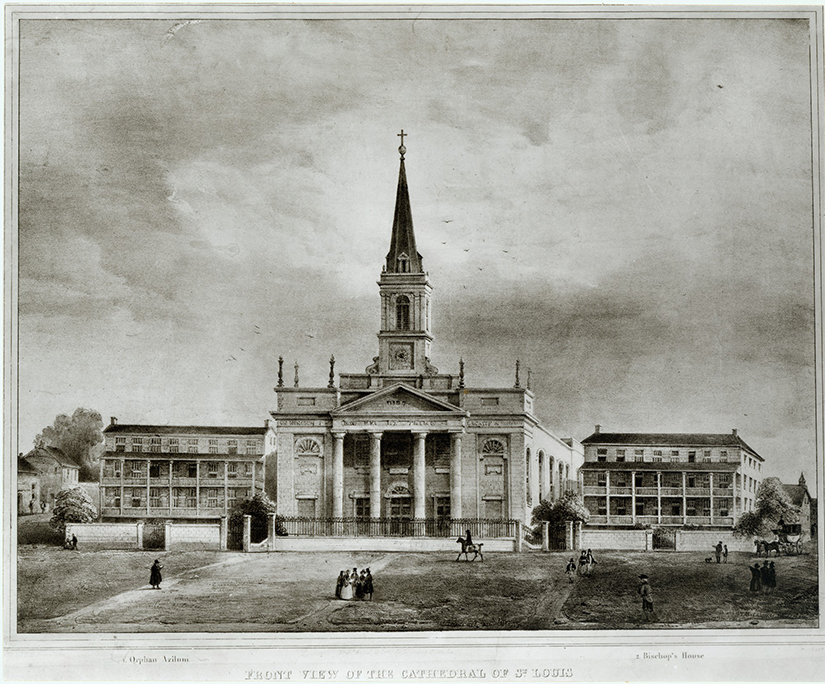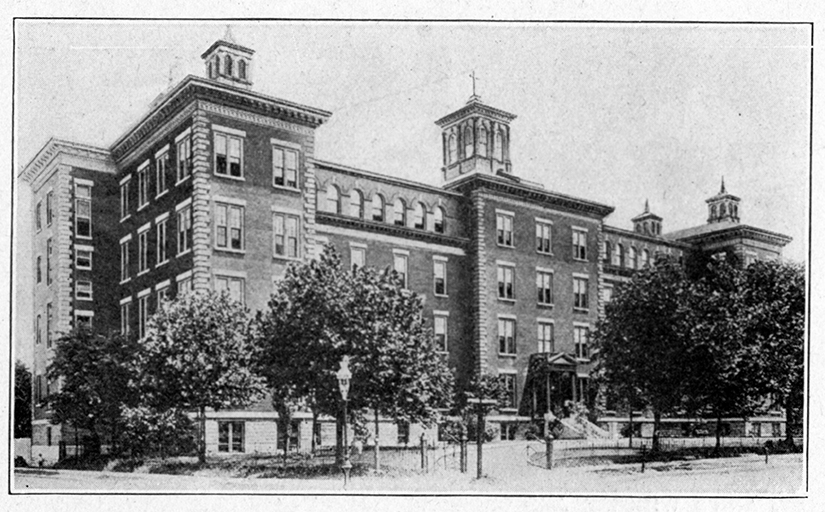 A lithograph by artist Leon Promenade of the Old Cathedral, shown in 1835. On the left is the St. Joseph’s Male Orphan Asylum, and on the right is the bishop’s residence.Photo Credits: PHOTO COURTESY OF MISSOURI HISTORICAL SOCIETY
A lithograph by artist Leon Promenade of the Old Cathedral, shown in 1835. On the left is the St. Joseph’s Male Orphan Asylum, and on the right is the bishop’s residence.Photo Credits: PHOTO COURTESY OF MISSOURI HISTORICAL SOCIETYIn 1828, the riverfront town of St. Louis was fast becoming a bustling commercial port, where steamboats arrived daily with goods and workers. American settlers from the East flocked here, and Irish and German immigrants began calling it home.
A census at the time showed about 5,000 residents, but within seven years, the diverse population had almost doubled. Crowded and unsanitary conditions prompted the need for social institutions to care for the sick and destitute. The Catholic Church in St. Louis was poised to fill two of those critical needs by establishing a hospital and orphanages in those early days.
Founded in 1828, the Mullanphy Hospital was the first hospital established west of the Mississippi River. Its namesake was John Mullanphy, a prominent Irish Catholic businessman and philanthropist. Mullanphy approached Bishop Joseph Rosati in 1826 with plans for a hospital. Mullanphy would supply the property and the funds for the building; Bishop Rosati needed only to find a group to run the hospital. Bishop Rosati wrote a letter to his friend Father Simon Bruté in Emmitsburg, Maryland, asking if the Sisters of Charity (today known as the Daughters of Charity) could staff the hospital. The sisters’ council sent four sisters to St. Louis. The hospital was located on Spruce Street between Third and Fourth streets. In the deed, Mullanphy specified that the hospital must care for “all such indigent sick free persons without regard to color, country or religion.”
 St. Louis Mullanphy Hospital, which was founded in 1828, was the first hospital established west of the Mississippi River. The building shown in the image was from 1874.Photo Credits: PHOTO COURTESY OF ARCHDIOCESAN ARHIVES
St. Louis Mullanphy Hospital, which was founded in 1828, was the first hospital established west of the Mississippi River. The building shown in the image was from 1874.Photo Credits: PHOTO COURTESY OF ARCHDIOCESAN ARHIVESThe first hospital was a three-room log cabin, and the number of patients quickly overwhelmed the small quarters. The small contingent of sisters soon grew to 12. A new hospital was built in 1831 to accommodate the city’s needs. It was built just before a cholera epidemic plagued the city. One of the first waves in 1832 killed more than 400 people in St. Louis, including two of the sisters working at the hospital. The annual cholera outbreaks sometimes claimed whole families, and left many children without parents and homeless.
Once again, John Mullanphy donated property and funds for an orphanage right next to Mullanphy Hospital. Run by the Sacred Heart sisters, this was the first orphanage opened in the state of Missouri. Then in 1834, the St. Louis Male Orphan Asylum was established next to the Old Cathedral at Third and Walnut streets and put in the hands of the Sisters of Charity. Within a year, there were 46 orphaned boys at the home.
In the midst of death and grief, Christ’s command to “love thy neighbor” inspired the Church in St. Louis to plant the seeds of compassion that would have long-lasting effects. The small three-room hospital developed into DePaul Hospital, which continues to be a respected name in health care, under SSM Health. The boys’ home was later taken over by the Sisters of St. Joseph of Carondelet and became the St. Joseph Home for Boys. The home cared for young men in need until its closure in 2001.
Schergen is an archivist with the Archdiocesan
Archives.